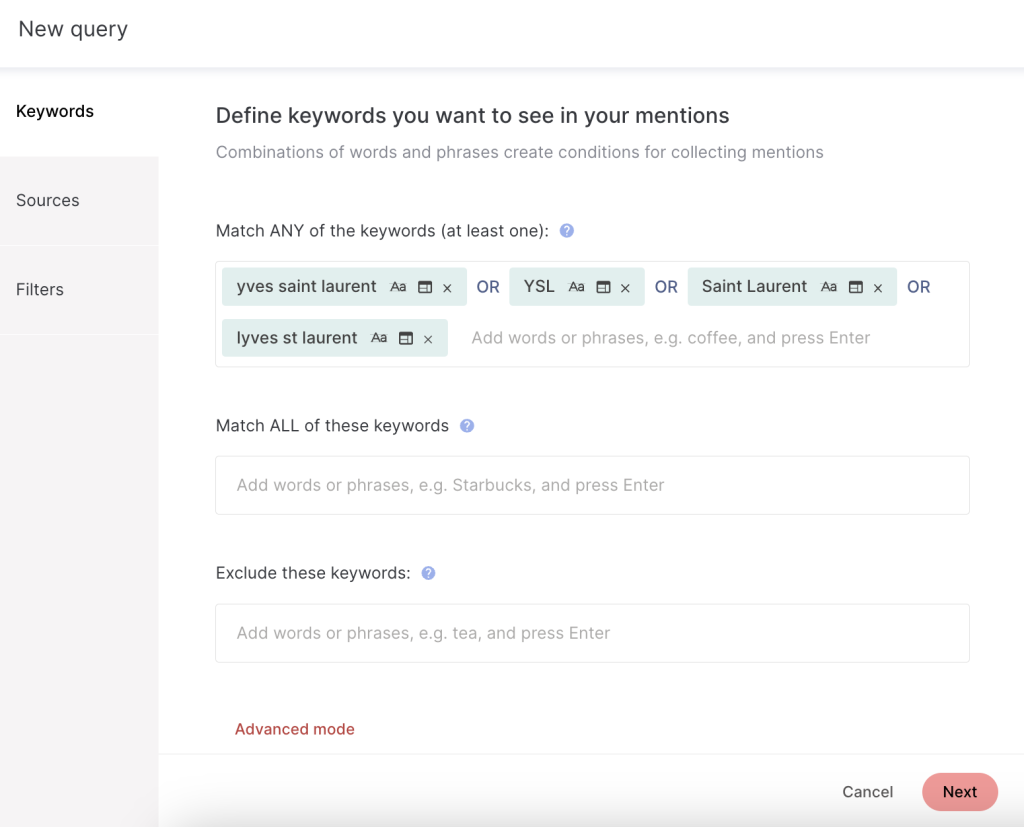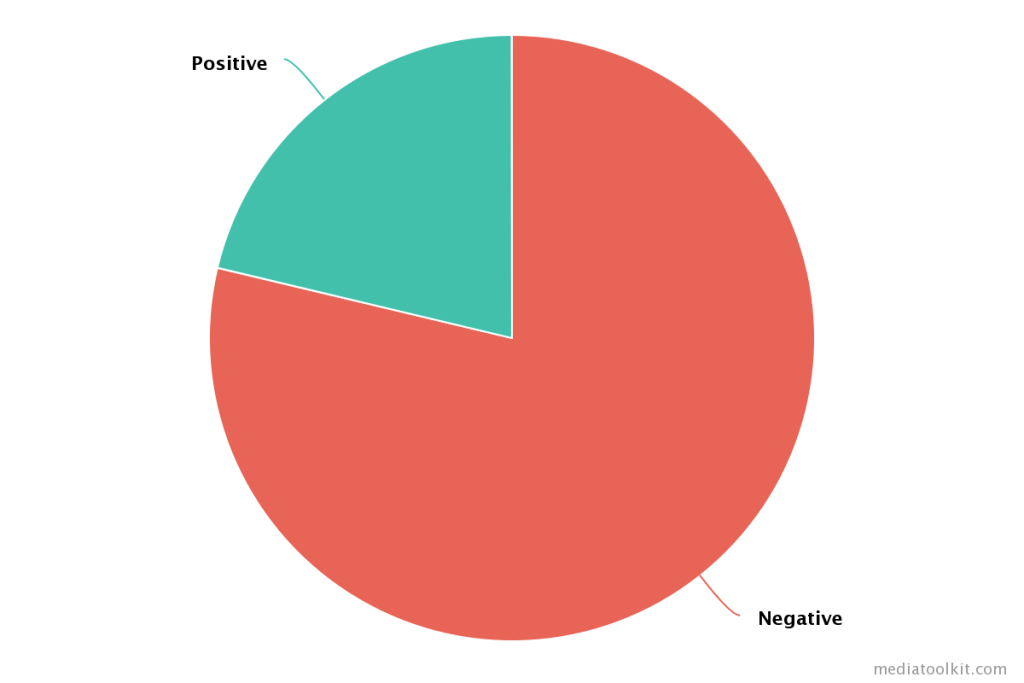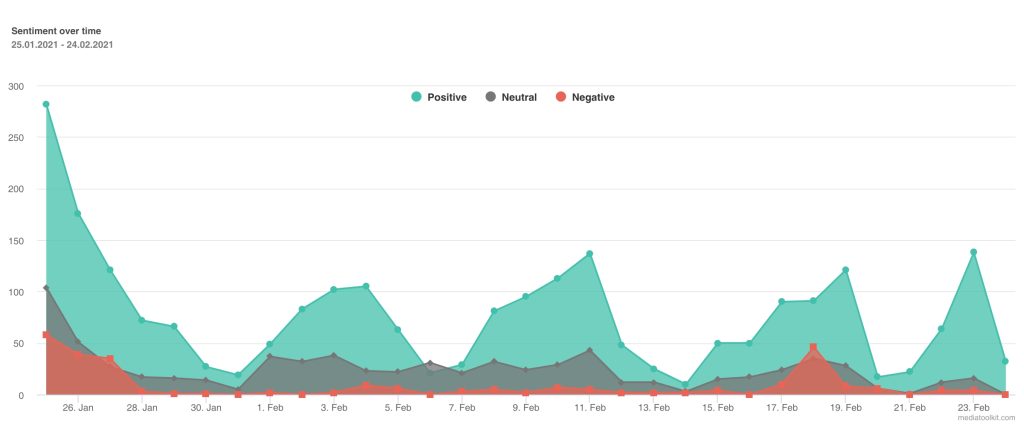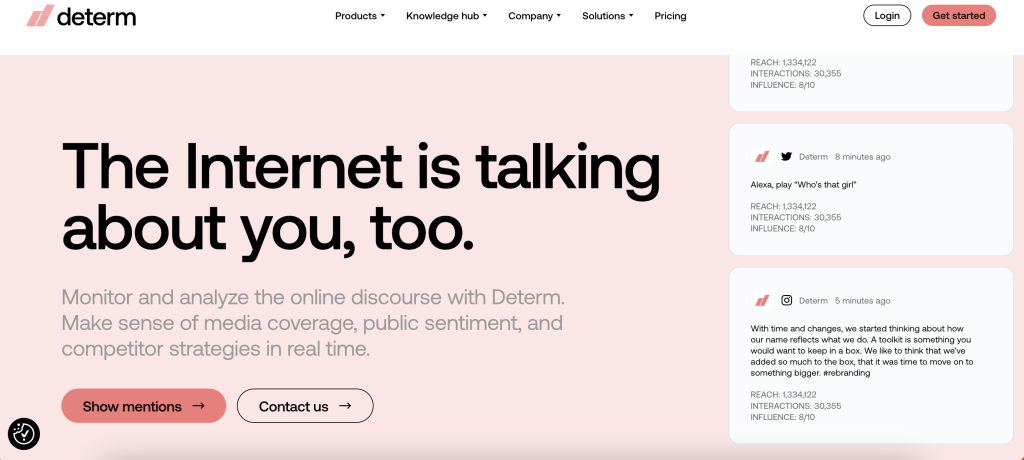It’s 2023. And if the previous year’s events have proven anything, it’s that people expect more from brands. To put it mildly, brands are now, more than ever, observed under a microscope. Every action elicits a reaction. This is why brands have to be especially vigilant in brand monitoring and tracking their online and offline presence.
? Read Media Monitoring: The Ultimate Guide
Not only does this help you avoid PR crises and build your brand reputation in the long term, but it also helps you discover new business opportunities. What those are, we’ll cover later in more detail. But first, let’s start with explaining what is actually considered brand monitoring.
What is Brand Monitoring?
Brand monitoring is the process of monitoring different channels to find mentions of your brand. In essence, it means collecting valuable data insights from your audience, and knowing where and how people are talking about your brand. Brand monitoring allows you to create an accurate perception of your brand, one based on the collected data.
What’s more, it’s not just about tracking and collecting data. It’s about actively reacting to your brand mentions. Basically, it’s about finding opportunities and eliminating threats. Like spotting and capitalizing on good publicity or getting ahead of a crisis. Learning how people feel about your products/services and improving them based on that feedback.
So, where do you start?
Channels to monitor
There’s a lot of different channels out there you can monitor for mentions. And it can be very easy to fall into a trap of wanting to track every single one for the mentions of your brand.
However tempting it may be to collect data from every single online and offline source you can get your hands on, think twice about it. This can lead you to collecting an overwhelming amount of data. Data that may be irrelevant or too vague to understand.
That’s why you should put more thought into how you choose channels to monitor – think about where your audience is, what channels make sense for your brand at the moment. Think quality, not quantity.
With that said, here’s a list of a few key channels you can monitor for your brand mentions:
- Print media
- Online media (news sites, publications, blogs)
- Forums (such as Quora or Reddit)
- Social media platforms
- Online review sites
Read How to Better Measure Your Existing Communications Channels (+How to Exploit New Ones)
What (topics) to monitor
Your brand name is an obvious one. But there are much more topics you should track to get a complete picture of your brand mentions. Even your brand name requires some further thought. So, let’s get into it.
Brand name and variations
Aside from tracking your very own brand name, you should also think about common name variations. This mostly refers to acronyms or abbreviations, brand nicknames, or common misspellings. Think about how your audience refers to your brand and include it in your tracking.
Take Yves Saint Laurent, for instance. Many people, when talking about this brand, won’t use its full name. Instead, you’ll often see their acronym YSL in their mentions. Other than that, people may refer to it as Yves St Laurent or Saint Laurent. Although Saint Laurent and Yves Saint Laurent refer to different things, as the first is used for clothing and accessories and the second for perfumes and cosmetics. As you can see, there are many things to consider even when it comes to just monitoring your brand name.

Products/services & campaigns
In addition to your brand name, you can track specific products and/or services you offer, as well as campaigns you create for promoting them. For instance, when you’re launching a new product and want to keep up with people’s reactions and comments, and how it affects the brand itself.
Let’s take YSL again as an example. They’ve just launched a campaign for their new perfume Libre featuring Dua Lipa. To monitor their brand for the duration of the campaign, they can track that specific product as well as the campaign itself (or rather the name associated with the campaign). This actually leads us to our next topic to monitor: key people.
Key people
These are the people, usually your employees, of certain influence in your organization and/or industry. From C-level executives (like CEO, CFO, CMO, etc.) to influencers or brand ambassadors you collaborate with. Any public figure associated with your brand should be on your list of topics to monitor.
Industry-related topics
This is more to keep up with the emerging trends and ongoing conversations in your industry or niche, and how it relates to your own brand. Even though your brand might not be directly mentioned, it’s still useful to know what’s being said about your industry as a whole. You might even use the knowledge you gather for new content ideas or product improvements.
On the other hand, if there’s a new crisis or controversy either related to your industry, competitors, or complementary products – it’s something you want to keep an eye on and see if it is something that will affect your own brand.
Competitors
Just as with the industry, it’s good to keep up with your competitors, too. To know what they’re up to and how their audience is talking about them. Of course, doing a competitor analysis is crucial in any business and for any brand, and many brand monitoring tools are great for that very purpose.
You can benchmark your own online presence against that of your competitors, even compare your social media activity to theirs. Determ, for instance, lets you see the share of voice between you and your competitors. Not only that, but you can compare how you and your competitors perform across different online channels and what is the prevailing sentiment.
This insight helps you get a deeper understanding of your brand’s online presence, offering you an insight into whether you need to improve your online strategy or not.
Read Competitor Analysis: Stay Ahead of Competition with Media Monitoring
Practical Uses of Brand Monitoring
As we’ve said at the beginning of this blog, brand monitoring is not just about tracking and collecting brand mentions, but more so about taking deliberate action based on the data you’ve collected.
Here are 5 practical uses of brand monitoring:
- Identifying opportunities for improvement & collaboration
- Detecting and managing crises
- Improving customer experience and boosting interactions
- Measuring campaign success
Identifying opportunities for improvement & collaboration
Monitoring your brand mentions gives you an insight into how people talk about your brand or specific products and services you offer. Online brand monitoring, specifically, gives you a unique opportunity to track real-time conversations and conduct real-time market research.
When people use their social media for talking about brands, they offer their honest, unbiased opinions. It’s like a running online commentary on your brand you can easily keep up with. These conversations help you understand how people perceive your brand, what they think about specific products, and what they need from you.
Let’s keep the Yves Saint Laurent example going. In 2019, they’ve launched a new Touche Éclat concealer. Until then, there was only their Touche Éclat illuminating pen, which was never really a concealer meant for covering spots and blemishes, more so for dark circles.
However, the lovers of their illuminating pen wanted something with a little more coverage and YSL delivered. Hence, the launch of their Touche Éclat High Cover Radiance Concealer.
This is exactly the kind of thing you can discover by brand monitoring. People freely share their experiences with different brands and products on social media. These experiences help you understand what’s good about your product and what requires improvement. You may even get an idea for a whole new product to satisfy the needs of your customers as YSL did.
What about discovering collaboration opportunities?
When talking about collaboration opportunities here, we’re talking about everything from influencers and brand ambassadors to affiliate marketing. Brand monitoring tools make discovering these opportunities a lot easier. Take Determ, for example.
For every mention, Determ calculates an influence score. This influence score is actually a number on a scale from 1 to 10 indicating how influential a particular mention source is compared to every other source. The lower the number, the smaller the audience and influence; the higher the number, the more influential the source.

You can even create a chart that will give you a list of mentions with the highest influence score, or even with the biggest reach.
This can be a gold mine for discovering people, blogs, or reviewers to collaborate with. You may discover that a review blog covered one of your products in their latest blog post or a person with a substantial social media following tagged you in their post.
Your research is the key
The important thing here is to do your own research after getting this information. Write down these brand mention sources that had the greatest impact, and do a little Google and social media search. Check out their social media profiles, their following, and the type of content they usually post. Check out their blog if they have it. Don’t focus on only one source of information. They may end up not being big on TikTok, but maybe they have a nice following on Twitter.
Their following and reach shouldn’t be the only thing you focus on, though. See if they’re the right fit for your brand. Would your brand values fit their own? Would it fit their usual content or would it obviously jump out and not in a good way?
Only then can you make an informed decision and decide whether to reach out or not.
Detecting and managing crises
Online platforms, social media especially, have given rise to the culture of speaking out against injustices, calling out problematic behavior, and demanding responsibility. Everyday people now have a voice in a way they never had before. One that can potentially reach thousands, millions of people across the world.
For brands, sometimes it’s a good thing. Other times, not so much.
A crisis is something that can happen to any brand, big or small. The crisis itself can be of a smaller scale and easily managed or it can grow out of control.
Brand monitoring helps you keep it under control.
Longer-term brand monitoring especially makes it easier to discover a crisis early on and manage it more effectively. When you monitor your brand continuously, you establish a certain pattern. You start to learn how your brand performs online, what is the average amount of mentions you gather, and what is the overall brand sentiment.
You have an insight into how your brand performs over time and what is the “normal” for your brand. So when something unexpected happens, you’ll notice immediately.
Of course, it’s worth noting that a spike in the number of your brand mentions does not necessarily mean a bad thing – but we are currently talking about crises.
Read Crisis Management Plan: How to Keep Your Business Afloat?
Sentiment ratio
The quickest way to know if it is something bad is to check the sentiment ratio. If it leans towards negative, you know you’re in a bit of trouble. To further confirm the possible crisis, scroll through the negative mentions to see what they’re about.

Let’s look at an example here. Fuse Chicken, a company that makes smartphone accessories, almost never found out their products were being counterfeited. It took a New York Times reviewer to discover it in 2017. Interested in writing about their product Bobine Auto, the NYT reviewer ordered it on Amazon, expecting to get the original. Suspicious of the actual product he received, he got in touch with Jon Fawcett, the founder and CEO of Fuse Chicken.
Needless to say, he received a counterfeit, and Fawcett learned that counterfeiters were using Amazon for selling and distributing their fakes.
The story is a good cautionary tale for other brands. Counterfeiting presents a challenge for companies as it can often affect their sales and reputation.
Read All You Need to Know About Brand Sentiment Analysis
Staying on top of things
Instead of discovering something like this from third parties, you can use brand monitoring to stay on top of things. Monitor your brand name closely and in relation to keywords like counterfeit, fake, copy, imitation, or knock-off. Keep an eye on conversations happening on social media. Maybe someone mentioned they just bought a knock-off, were complaining about the quality, posted a picture.
What’s more, you can even monitor your competitors or industry in general. So, if something like this happened to your competitors or complementary products, it would be a good idea to check for counterfeiting of your own products.
And counterfeiting is just one of the more complicated examples. When talking about a crisis, it can be as simple as a tweet going viral or someone bringing up an insensitive email subject line – which actually happened to Adidas in 2017:
Just three years earlier, Boston Marathon was a place of a terrorist attack that left 3 people dead and hundreds injured. So the subject line “Congrats, you survived the Boston Marathon” unintentionally referred to the attack. Instead of ignoring the situation, though, Adidas issued an apology:
With brand monitoring, not only are these things easily and quickly caught, but you can track the progress of the crisis. How are people reacting, how fast is it spreading, or does your released statement make the situation better or worse?
Improving customer experience and boosting interactions
We’ve talked about how to avoid crises, now let’s talk about how to encourage interactions and improve your customers’ experience with your brand.
This mostly refers to social media, as that is currently the place that made it possible for brands and customers to have two-way communication. It’s no more brands talking into the void that doesn’t talk back. Now, it’s a conversation.
By inviting and encouraging interaction, brands no more feel like this big commercial presence. Social media has put brands and consumers on more of an equal footing. In fact, today’s consumer is more powerful than ever and has higher expectations from brands.
That’s why brands more and more often engage consumers in conversations online. Answering their questions, helping them out, replying to their tweets. It goes a long way in showing consumers you care and building a trusting relationship.
For instance, Wendy’s has mastered the art of cheeky Twitter replies:
And Netflix ever faithfully follows its shows’ mentions and delivers funny, relatable responses:
Monitoring your brand, especially social media mentions, helps you find any inquiries and comments your customers may have. You can see what your audience is tweeting or commenting, and you can reply to those comments, retweet their tweets, or use the user-generated content to further promote the product.
Measuring campaign success
Last, but not least is monitoring and measuring campaign performance. Whenever you have a new campaign, you can make sure to monitor your brand alongside campaign keywords: campaign name, hashtag, people involved, product/service or event you’re promoting…
This way you can track the effect the campaign has on your brand. You can get information about the reach the campaign had and how people talk about it. Are they liking it or not? Here, sentiment analysis can give you a quick answer. Just by checking the sentiment ratio, you can know if the response is positive or negative.

If you’ve collaborated with multiple influencers or brand ambassadors on the campaign, you can easily compare their performance results. For instance, Determ allows you to create tags for each influencer/brand ambassador and use those tags to create charts (like the share of voice chart).
Just remember the “what topics to track” part from the beginning of the blog. When it comes to brand monitoring, it’s important to keep in mind factors other than just your brand name.
Your brand name is a great starting point, but for more context, you want to expand your monitoring to topics closely related to your brand. Especially when it comes to tracking things like the performance of your marketing campaign and how it affects your brand.
The Quality of Mentions
You can see if your brand generates more mentions in that period (which usually will be the case), you can see whether those mentions are positive or negative. If they’re positive, you can go through the positive mentions and make sure to reply to comments and tweets – engage your audience even further. You can even use UGC to further promote your brand or retweet your audiences’ tweets.
On the other hand, if more brand mentions are negative, it’s time to do damage control. Find out what caused the outpouring of negative mentions and work to manage and fix the situation before it leaves lasting negative effects on your brand.
Best Brand Monitoring Tools
There’s a lot of brand monitoring tools out there, so we’ve compiled a list of some of the best:
Google Alerts
It’s free! Google Alerts is one the more simple and easy-to-use options when it comes to brand monitoring tools. Just enter the keywords you want to monitor and your email address. When someone mentions those keywords, you’ll get an email.
It is rather basic, though. Contrary to many other brand monitoring tools, Google Alerts doesn’t have any additional features and analytics. You only get the mentions.
Ahrefs

An SEO tool first, and a brand monitoring tool second, Ahrefs still makes the list due to its great backlink analysis and competitor monitoring. You’ll know whenever someone links to your site, even if they don’t directly mention your name.
What’s more, it can be a great jumping-off point when it comes to figuring out what exactly to track. With the help of their keywords explorer, you can discover how people use your brand name. Maybe you’ll discover new nicknames or common misspellings you can use when tracking your brand name.
Not free, but still worth it!
Determ

Yes, yes, it’s us. But we’re on the list for a reason. We’re through and through a brand monitoring tool that tracks over 100 million online sources – from websites and forums to social media platforms. It’s real-time with a well-developed alerts system: we offer both Spike Alerts and digests (mention overviews you can receive by mail on a daily, weekly, or monthly basis). And best of all, we have analytics. You can use predefined report dashboards, or create and customize your own charts.
While we’re not free, we do offer a free 1-week trial after you book a demo.
TweetDeck

It’s best for community management, but if you’re only interested in Twitter brand mentions, this is still a good option. You can create a personalized dashboard, add and remove columns and keep an eye on hashtags and brand mentions. Best of all, it’s free!
Brandwatch

Another tool fully developed for brand monitoring. It’s one of the best out there, but also one of the most expensive. It tracks your mentions in real-time, but also offers historical data based on machine learning. It uses artificial intelligence to spot audience and brand insights and create reports.
It’s mostly geared towards larger companies and the price is available upon request.
LexisNexis
This media monitoring tool stands out from the rest on the list because it also covers print. In fact, in their words: “Nexis Newsdesk is an all-in-one media monitoring tool with the most comprehensive content collected from broadcast, print, news, social, blogs and top publishers.”
In Conclusion
Monitor your brand. It’s as simple of a conclusion as that. Nowadays, you truly cannot get away with staying ignorant about your brand’s online presence. Oftentimes, your tags are not enough of an insight into your brand perception.
We can’t stress enough the power consumers have gained with the neverending parade of social media platforms. And we can’t stress enough the benefits your brand will reap if you listen to what your customers have to say. Learn from them, empathize with them, be grateful they’re holding you accountable. As much as your customers and media can bring you up and help you improve your products and reputation, they can just as much bring you down and call you out.
So buckle up, and start monitoring your brand!



